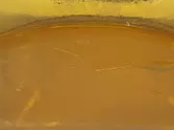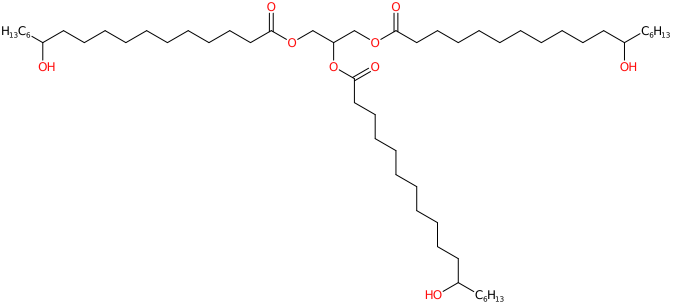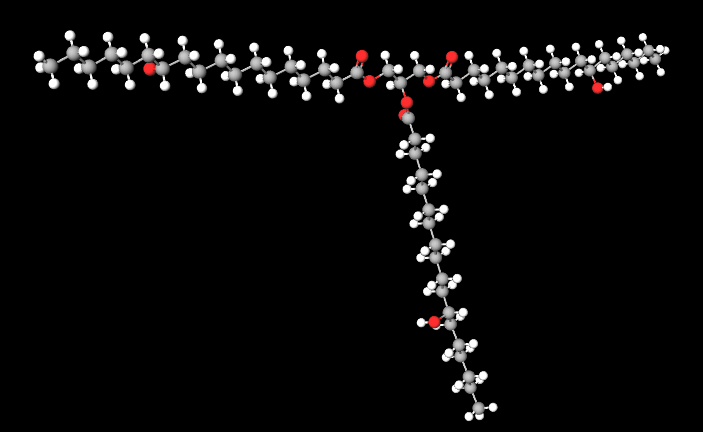| "Descrizione" by Al222 (23403 pt) | 2023-Nov-26 12:12 |
Review Consensus: 18 Rating: 9 Number of users: 2
| Evaluation | N. Experts | Evaluation | N. Experts |
|---|---|---|---|
| 1 | 6 | ||
| 2 | 7 | ||
| 3 | 8 | ||
| 4 | 9 | ||
| 5 | 10 |
PEG-40 Hydrogenated Castor Oil is a brittle and hard vegetable wax. a polyethylene glycol derivative of castor oil. It is used as an emulsifier and surfactant in various cosmetic and personal care products. Its primary function is to help mix water with oils and other ingredients that would not normally blend together.
The name defines the structure of the molecule:
- PEG-40. PEG stands for polyethylene glycol, a polyether compound formed by repeated units of ethylene glycol. "40" is the average number of ethylene glycol units in the polymer chain. PEG are widely used in cosmetics and personal care products for their emulsifying, solubilizing and moisturizing properties.
- Hydrogenated Castor Oil. Castor oil is a vegetable oil obtained from the seeds of the castor plant (Ricinus communis) and produced by the hydrogenation process, which adds hydrogen atoms to the oil to increase its stability and modify its physical properties. Hydrogenated castor oil is often used in cosmetic formulations as an emollient agent, thickener and surfactant.
The synthesis process takes place in several stages:
- Hydrogenation. Castor oil is a vegetable oil obtained by pressing the seeds of the castor plant. The oil is then hydrogenated, which involves the addition of hydrogen (H2) in the presence of a catalyst. This process increases the melting point of the oil, making it a solid at room temperature.
- PEGilation. Hydrogenated castor oil is reacted with ethylene oxide in a process known as pegylation. This process connects polyethylene glycol (PEG) chains to hydrogenated castor oil, increasing its solubility in water and improving its surfactant properties.
So,a combination of synthetic polyethylene glycol (PEG) obtained by catalytic hydrogenation of chemically produced castor oil using an ethoxylation process with a chemical reaction in which ethylene oxide is added to a castor oil substrate. It is mixed through etherification and esterification of hydrogenated castor oil glycerides and fatty acids with forty ethylene oxide units. The number 40 appearing after the abbreviation PEG represents the molecular weight and the higher this number is, the less it penetrates the skin.
Synthetically, it appears as white flakes or an oily transparent liquid. Flammable. Incompatible with strong oxidising agents. Insoluble in water and characteristic smell. It contains 40 mol of ethylene oxide.


What it is used for and where
Hydrogenated castor oil is used in water to solubilise synthetic spices and essential oils by mixing the required solubilising substance in the proportion of 1: 1-3 while stirring until a transparent mixture is achieved.
Cosmetics
Non-ionic surfactant, rheological additive for sunscreens, production and manufacture of various water-based products for washing, make-up, rich in omega fatty acids possesses antifungal and antibacterial activity. It is an emulsifier and moisturiser used in cosmetic formulations for liquid soaps, shampoos, tanning creams and more. Useful in the treatment of dandruff and as a conditioner for dry hair.
Emulsion stabiliser. Emulsions are thermodynamically unstable. Emulsion stabilisers improve the formation and stability of single and double emulsions. as well as their shelf-life. It should be noted that in the structure-function relationship, the molar mass of the ingredient used plays an important role.
Surfactant - Emulsifying agent. Emulsions are thermodynamically unstable and are used to soothe or soften the skin and emulsify, so they need a specific, stabilising ingredient. This ingredient forms a film, lowers the surface tension and makes two immiscible liquids miscible. A very important factor affecting the stability of the emulsion is the amount of the emulsifying agent. Emulsifiers have the property of reducing the oil/water or water/oil interfacial tension, improving the stability of the emulsion and also directly influencing the stability, sensory properties and surface tension of sunscreens by modulating the filmometric performance.
Medical
It is able to partially remove scars produced by acne.
Other uses
It is used in insecticides, water-soluble flavourings, fungicides, coolants, mosquito repellents.
Hydrogenated castor oil is a derivative of castor oil and is obtained by catalytic hydrogenation of castor oil. It significantly reduces the unsaturated double bond in castor oil molecules, so that it decreases the possibility of double bonds inducing yellowing of animal skins used for clothing (1).
An evaluation of the safe use of high concentrations of hydrogenated castor oil (PEG-40) as surfactant for oral nanoemulsion was performed in Webster mice. In particular, considering in vivo data, it is suggested that nanoemulsion composed with a high amount of hydrogenated castor oil PEG-40 is acceptable for the oral delivery of active compounds (2).
It improves the corrosion resistance of carbon steel in simulated fuel ethanol (3).
Used as an adjuvant for coatings.
Provides resistance to failure in thixotropic epoxy mortars and in solvent-based coatings, inks and adhesive systems.
For more information:
PEG-40 Hydrogenated Castor Oil studies
Typical commercial product characteristics Hydrogenated Castor Oil
| Appearance | Yellowish liquid or white flakes |
| pH | 5.0~7.0 |
| Boiling Point | 872.4±30.0°C at 760 mmHg (liquid) |
| Melting Point | ≥85°C (flakes) |
| Flash Point | 220.1±18.1°C (liquid) |
| Density | 1.0±0.1 g/cm3 |
| Refraction Index | 1.478 |
| Vapor Pressure | 0.0±0.6 mmHg at 25°C |
| LogP | 18.70 |
| Saponification value | 57~67 (liquid) 176-186 mgKOH/g (flakes) |
| HLB | 13~14 (liqiod) |
| Iodine | ≤ 2.5 gl/100g (flakes) 82-92 (liquid) |
| Acid Value | ≤ 2.0 Mg KOH/g (flakes) 175-185(liquid) |
| Particle size | dv98≤20 μm (flakes) |
| Hydroxy Value | ≥ 155 Mg KOH/g (flakes) |
| Water | 0.5% max (liquid) |
 |  |
 |  |
- Molecular Formula C57H110O9 C21H23ClFNO2
- Molecular Weight 939.498
- Exact Mass 938.815002
- CAS 8001-78-3 61788-85-0 (POLYOXYETHYLENE HYDROGENATED CASTOR OIL 60)
- UNII 06YD7896S3
- EC Number 232-292-2
- DSSTox Substance ID DTXSID8027666 DTXSID3051701
- IUPAC 2,3-bis(12-hydroxyoctadecanoyloxy)propyl 12-hydroxyoctadecanoate
- InChl=1S/C57H110O9/c1-4-7-10-31-40-51(58)43-34-25-19-13-16-22-28-37-46-55(61)64-49-54(66-57(63)48-39-30-24-18-15-21-27-36-45-53(60)42-33-12-9-6-3)50-65-56(62)47-38-29-23-17-14-20-26-35-44-52(59)41-32-11-8-5-2/h51-54,58-60H,4-50H2,1-3H3
- InChl Key WCOXQTXVACYMLM-UHFFFAOYSA-N
- SMILES CCCCCCC(CCCCCCCCCCC(=O)OCC(COC(=O)CCCCCCCCCCC(CCCCCC)O)OC(=O)CCCCCCCCCCC(CCCCCC)O)O
- MDL number
- PubChem Substance ID
- NCI C83764
- RXCUI 1310538
- NSC 2389
Synonyms :
- 1,2,3-Propanetriyl tris(12-hydroxyoctadecanoate)
- Glycerol tris(12-hydroxystearate)
- Thixcin,
- Glyceryl tris(12-hydroxystearate)
- 12-Hydroxystearic acid triglyceride
References____________________________________________________
(1) Ma J, Duan L, Lu J, Lyu B, Gao D, Wu X. Fabrication of modified hydrogenated castor oil/GPTMS-ZnO composites and effect on UV resistance of leather. Sci Rep. 2017 Jun 16;7(1):3742. doi: 10.1038/s41598-017-03879-3.
(2) Rachmawati H, Novel MA, Ayu S, Berlian G, Tandrasasmita OM, Tjandrawinata RR, Anggadiredja K. The In Vitro-In Vivo Safety Confirmation of PEG-40 Hydrogenated Castor Oil as a Surfactant for Oral Nanoemulsion Formulation. Sci Pharm. 2017 Mar 31;85(2):18. doi: 10.3390/scipharm85020018.
(3) Deyab MA. Utilization of a nonionic surfactant for improved corrosion resistance of carbon steel in simulated fuel-grade ethanol. RSC Adv. 2018 Jun 7;8(37):20996-21001. doi: 10.1039/c8ra02936a.
_____________________________________________________________________________
And a premise on PEG.
Since the PEG (1) family is numerous and is found in many cosmetic, cleaning and medicinal products and others, we need a cognitive premise on the subject that is rather complex from the point of view of safety because these products not only come into contact with the skin but, as in the case of medicine, they are also ingested.
PEG or polyethylene glycols polymerise the condensed ethylene oxide and water and are called polyethylene glycols, but in reality, they are complex chemical components, polymers bound together. For example, plastic is polyethylene and has a hard consistency, while polyethylene aggregated to the glycol forms a liquid.
The number that appears after the initials PEG represents the molecular weight and the higher this number is, the less it penetrates the skin.
Here below are some studies in Medicine that refer to the use of PEG Polyethylene glycol in various fields.
Intestine
Polyethylene glycol with or without electrolytes is effective for the treatment of functional constipation, both in adults and in paediatric patients, with great safety and tolerability. These preparations are the most effective osmotic laxatives (more than lactulose) and are the first-line treatment for functional constipation in the short- and long-term. They are as effective as enemas in faecalomas, avoid the need for hospitalisation and are well tolerated by patients (especially when given without electrolytes) (2).
In the preparation for colonoscopy, polyethylene glycol tablets confirmed efficacy, acceptability, tolerance and safety similar to those of sodium phosphate (3).
For peripheral nerve repair (4).
Eyes
Dry eye syndrome is a disorder that affects 5-34% of the world's adult population with reduced quality of life. Artificial or lubricating tears are the most used therapy for treating this condition due to their low side effects profile, which attempt to modify the properties of the tear film. Polyethylene glycol has demonstrated clinical efficacy in the treatment of this condition (5).
Brain
Polyethylene glycol facilitates the neuroprotective effects of magnesium in head injuries (6).
Tumors
For transarterial chemoembolization, Polyethylene glycol is effective and safe for the treatment of liver cancer, as indicated by good tolerability, quality of life and high tumour response (7).
Cosmetics
Many types of PEG are hydrophilic and are used as creams, topical dermatological preparations and in cosmetic products such as surfactants, emulsifiers, detergents, humectants and skin conditioners.
Safety varies from type to type given the structural complexity (8).
References___________________________________________________________________
(1) Fruijtier-Pölloth C. Safety assessment on polyethylene glycols (PEGs) and their derivatives as used in cosmetic products. Toxicology. 2005 Oct 15;214(1-2):1-38. doi: 10.1016/j.tox.2005.06.001.
(2) Mínguez M, López Higueras A, Júdez J. Use of polyethylene glycol in functional constipation and fecal impaction. Rev Esp Enferm Dig. 2016 Dec;108(12):790-806. doi: 10.17235/reed.2016.4571/2016.
Santos-Jasso KA, Arredondo-García JL, Maza-Vallejos J, Lezama-Del Valle P. Effectiveness of senna vs polyethylene glycol as laxative therapy in children with constipation related to anorectal malformation. J Pediatr Surg. 2017 Jan;52(1):84-88. doi: 10.1016/j.jpedsurg.2016.10.021.
(3) Chaussade S, Schmöcker C, Toulemonde P, Muñoz-Navas M, O'Mahony V, Henri F. Phosphate tablets or polyethylene glycol for preparation to colonoscopy? A multicentre non-inferiority randomized controlled trial. Surg Endosc. 2017 May;31(5):2166-2173. doi: 10.1007/s00464-016-5214-1.
Tsunoda T, Sogo T, Iwasawa K, Umetsu S, Oikawa-Kawamoto M, Inui A, Fujisawa T. Feasibility and safety of bowel cleansing using low-volume polyethylene glycol with ascorbic acid before pediatric colonoscopy: A pilot study. Dig Endosc. 2017 Mar;29(2):160-167. doi: 10.1111/den.12756.
(4) Hoffman AN, Bamba R, Pollins AC, Thayer WP. Analysis of polyethylene glycol (PEG) fusion in cultured neuroblastoma cells via flow cytometry: Techniques & optimization. J Clin Neurosci. 2017 Feb;36:125-128. doi: 10.1016/j.jocn.2016.10.032.
(5) Pérez-Balbuena AL, Ochoa-Tabares JC, Belalcazar-Rey S, Urzúa-Salinas C, Saucedo-Rodríguez LR, Velasco-Ramos R, Suárez-Sánchez RG, Rodríguez-Carrizalez AD, Oregón-Miranda AA. Efficacy of a fixed combination of 0.09 % xanthan gum/0.1 % chondroitin sulfate preservative free vs polyethylene glycol/propylene glycol in subjects with dry eye disease: a multicenter randomized controlled trial. BMC Ophthalmol. 2016 Sep 20;16(1):164. doi: 10.1186/s12886-016-0343-9.
Labetoulle M, Messmer EM, Pisella PJ, Ogundele A, Baudouin C. Safety and efficacy of a hydroxypropyl guar/polyethylene glycol/propylene glycol-based lubricant eye-drop in patients with dry eye. Br J Ophthalmol. 2017 Apr;101(4):487-492. doi: 10.1136/bjophthalmol-2016-308608.
(6) Busingye DS, Turner RJ, Vink R. Combined Magnesium/Polyethylene Glycol Facilitates the Neuroprotective Effects of Magnesium in Traumatic Brain Injury at a Reduced Magnesium Dose. CNS Neurosci Ther. 2016 Oct;22(10):854-9. doi: 10.1111/cns.12591.
(7) Aliberti C, Carandina R, Sarti D, Mulazzani L, Catalano V, Felicioli A, Coschiera P, Fiorentini G. Hepatic Arterial Infusion of Polyethylene Glycol Drug-eluting Beads for Primary and Metastatic Liver Cancer Therapy. Anticancer Res. 2016 Jul;36(7):3515-21.
(8) Jang HJ, Shin CY, Kim KB. Safety Evaluation of Polyethylene Glycol (PEG) Compounds for Cosmetic Use. Toxicol Res. 2015 Jun;31(2):105-36. doi: 10.5487/TR.2015.31.2.105.
| Evaluate |
